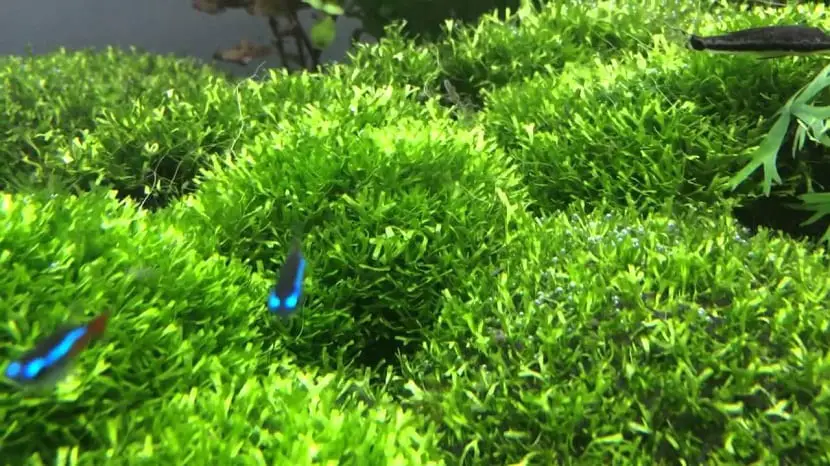
The aquatic plant Riccia fluitans is a form of moss that it is found naturally on all continents of the worldIt was made popular by the Japanese Takashi Amano who kept them in his aquarium.
The plant is commonly used for define landscape shapes in high-end display tanks. Due to this growing popularity, Riccia is becoming a common plant in aquariums.
Characteristics of the Riccia Fluitans

The plant is made up of several tiny plants that can be snuggled together to form a beautiful foreground rug or even a mid-plan transitional plant.
There four different varieties from Japan, Europe, Thailand and Singapore. However, only the variety from Japan is suitable for submerged cultivation.
Riccia fluitans grows as a floating plant and once it becomes large enough, will start to sink naturally. The plant is rootless and cannot attach itself to anything. The best way is to anchor it to solid objects, tying it with a mesh to keep it attached to rocks or driftwood.
This plant is very versatile, you can also use it as a ground cover where you can form a nice bright green lawn. If you use it as a floating plant, it will serve to provide shelter for fry or shrimp.
Cultivation of the Riccia Fluitans
The Riccia floating it is easy to grow and can be propagated by transferring them in spring to an area with plenty of water.
Its wide distribution can be attributed to the fact that it tolerates a multitude of different environmental conditions, for example, water hardness levels from very soft to very hard and pH values between 6 and 8 and temperatures between 15 and 30 ° C.
As a floating plant it requires sufficient light intensity.
When you leave it floating near the light source, can easily double in size in about five days. When you submerge it, the growth rate is a little slower.
Hiccup Floating care
Wrapped tightly between the rock and the net or thread, the fine branches of Riccia will grow between the cracks and will form a dense mound intertwined.
Requires pruning and maintenance for optimal health. Once established, it tends to grow very rapidly and can develop dead spots in your dough when overgrown.
La Riccia has a tendency to grow to the shape of the element to which it is attached, if you let it grow too long, the pieces of Hiccia floating will tend to separate from the main mass and end up on other floors or around a filter inlet.
When you go to cut it, the plant will look very elegant, in addition you can use it to create the illusion of an underwater tree when attached to thin driftwood branches.

For the maintenance of the trim, it is best to turn off the filter first and then trim with scissors. Clean all floating debris before turning the filter back on.
If you do not want to be constantly maintained by the growth and volume of La Riccia, there is a dwarf variety of Riccia fluitans that contains smaller branches and has a slower growth rate.
The plant likes to have a high supply of nutrients, nitrate, phosphate, iron and potassium, these being a necessity. A supplement from CO 2 it’s profitablewill contribute to much faster growth and stability.
Under good growing conditions, oxygen bubbles form at the tips of the leaveswhich also offers good protection for bubble-nesting fish such as Betta and Gourami, they will also enjoy building their nests around and under the floating plant.
You cannot grow it together with duckweedas it grows too fast and will strangle the Riccia Fluitans plant. After these aquatic plants die, its decomposition by bacteria and fungi provides food for many aquatic invertebrates called ‘detritus’.
